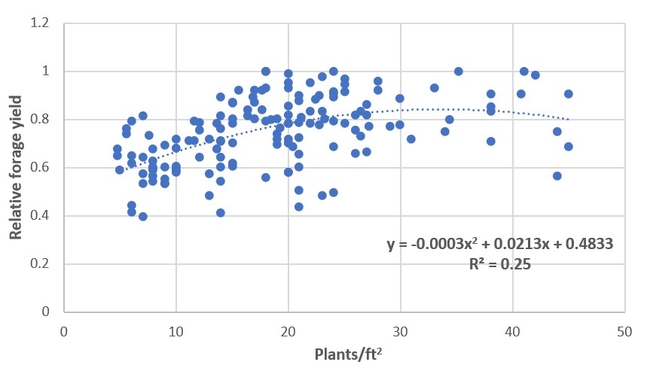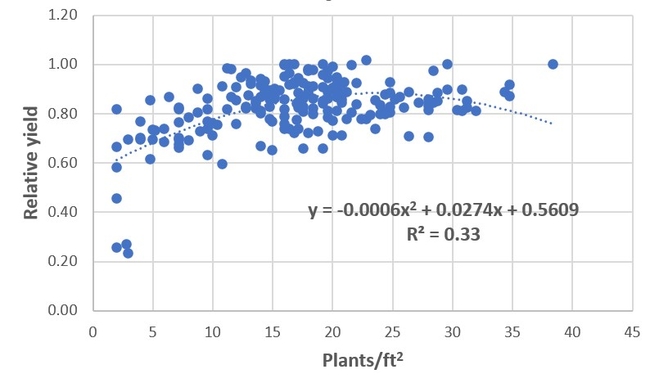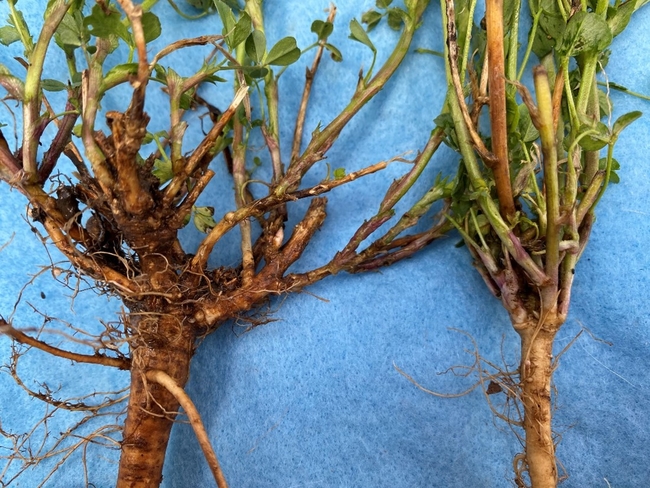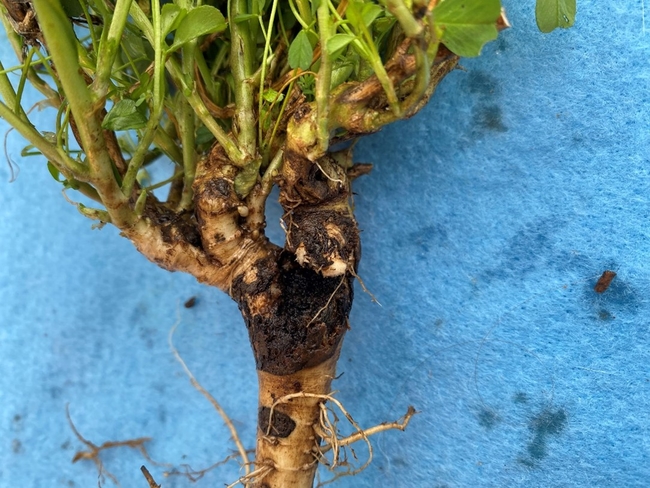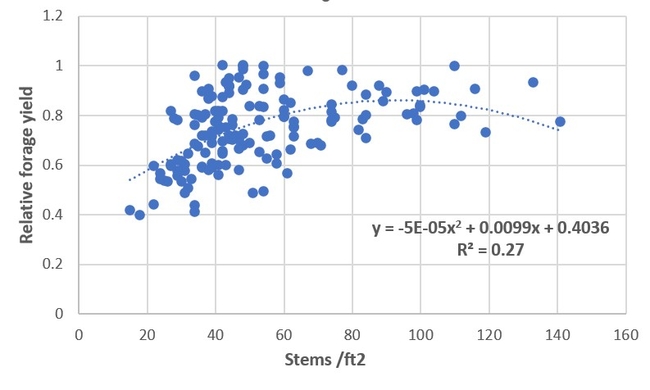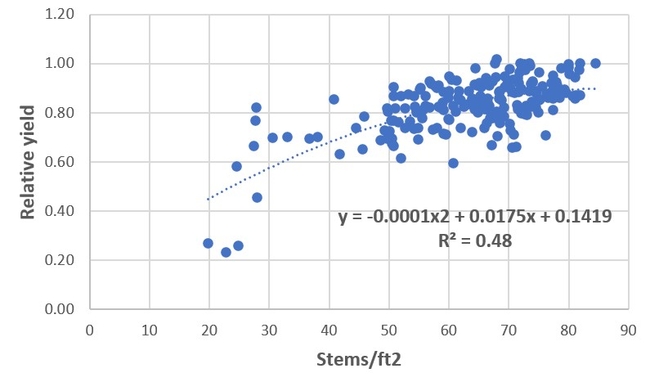The best method for determining the forage yield potential of an alfalfa stand is by directly measuring yield at harvest. However, researchers at the University of Wisconsin have estimated forage yield by measuring plant and stem density.
Stem and plant density measurements can help determine the success of establishment, forage yield potential after winter injury, and timing of stand termination. Stand evaluations are typically performed in both fall before dormancy and spring once regrowth is over two inches tall. However, in some instances these methods can be used during the season to determine if stand issues need to be remedied. The importance of these evaluations for management decisions indicates a need to better understand how these numbers are derived and whether they are dependable predictors of yield.
Alfalfa plant density study
Study details
To better understand relationships between alfalfa plant density, stem density and alfalfa yield, researchers conducted a three-year study at three Minnesota locations: St. Paul, Becker, and Rosemount. Four modern alfalfas with fall dormancy ratings of 4 and 5 were established using seeding rates from 5 to 72 seeds/ft2. These seeding rates resulted in stands with a wide range of plant densities. Yield data was collected from two harvests in the seeding year and from three or four harvests at bud stage in the first two years after seeding. Stem densities were taken at each harvest while plant densities were taken in the spring and fall. Averages over locations, harvests, and densities were used in the analysis.
Plant density and forage yield
Alfalfa stand density, defined as the number of plants per square foot (plants/ft2), has long been used as a predictor of forage yield and when to terminate stands in rotation. A plant density of 25-30 plants/ft2 or more is recommended in fall of the seeding year. This provides not only for maximum yields but also enough plants to overwinter and for productive stands in subsequent years. Seeding rates typically used by producers in the 10-20 pounds per acre range provide from 50-75 seeds per square foot (seeds/ft2). Assuming 50% seed mortality during the seeding year, these rates are normally adequate to achieve a goal of 25 plants/ft2 in the fall.
Seeding year
Recent results show that seeding year yields were maximized at 3-4 tons per acre at alfalfa densities of about 30 plants/ft2 (Figure 1). Figure 1 shows negligible change in seeding year yields from 20-40 plants/ft2, as indicated by the line of best fit. However, as judged by the low R2 value of 0.25, plant populations are a poor predictor of yields. An R2 (the coefficient of determination) value – a measure of predictive power of the regression model – of 1 would mean that 100% of the yield is predicted by plant density.
1st and 2nd production years
Likewise, in the first (Figure 2) and second production years (data not shown), plant densities were overall a poor predictor of yield. Despite the poor predictive power of plant density, this method shows that there is a significant drop off in yields at densities less than 10 plants/ft2. Traditional recommendations use plant densities of less than 5 plants/ft2 to indicate poor stand yield potential.
Stem density and forage yield
As alfalfa stands age, competition for resources, diseases, and crown injury due to winter and traffic reduce plant density. Decreases from 25 plants/ft2 in the fall of the seeding year to 5-10 plants/ft2 by the end of the second production year are commonly reported. This reduction in plant density is compensated by an increase in plant root and crown size and stem numbers per plant (Figure 3). However, injury to older crowns by traffic or disease can reduce the numbers of stems and productivity of individual stems (Figure 4).
University of Wisconsin research with one to three year old stands found that stem density was a better predictor of alfalfa yield than plant density. Those researchers recommended using a combination of stand density and plant health to predict yield and stand termination. At a critical level of more than 55 stems/ft2, future yield was not limited by stem density. At 40-55 stems/ft2, some yield reduction was expected depending on the health of roots.
Recent results also show that stem density is a better predictor of alfalfa yield than plant density beginning in the year after seeding. While stem density is a poor predictor of yield in the seeding year (Figure 5), it was a better predictor in the first and second production years (R2= .48) (Figure 6).
This level of prediction was somewhat less than levels reported in the Wisconsin research discussed above. In addition, stem densities of about 70 stems/ft2 maximized forage yields in this study, a somewhat higher number than the 55 stems/ft2 reported for Wisconsin. At 55 stems/ft2, yields in this study were about 80% of the maximum yield. When both stem density and plant density were considered for prediction of yield, the effectiveness of prediction (R2) did not increase.
Summary
In seedling to second year healthy alfalfa stands, stem density was a better predictor of yield than plant density in this study. Combining plant density and stem density into a prediction equation did not improve the accuracy of prediction. Plant densities less than 10/ft2 did result in a significant yield decline in the years following the seeding year.
It is important to clarify that the predictive relationships between stem density and yield explained less than 50% of the changes in yield. Even earlier research in Wisconsin found that stem density changes explained less than 60% of the changes in yield. These results show that other plant morphological traits, such as stem mass and stem leafiness, interact to affect yield. Biotic conditions like crown diseases and environmental conditions, such as drought and soil fertility, can also affect the relationship of both stem and plant densities with yield.
The results from these two studies stress the importance of ongoing monitoring when making decisions about alfalfa stand productivity and rotation to other crops:
- Monitor alfalfa forage yield over the life of the stand. Normally, forage yield declines after the first two years of production. Use yield data and costs of production to determine changes in profitability.
- Monitor the changes in alfalfa stem density, plant density, and plant height over the life of the stand. While stem and plant densities are imperfect predictors of future yields, they can provide a general guideline that along with yield data will allow for decision making.
- Monitor the changes in alfalfa crown health over the life of the stand.
Reviewed in 2023


